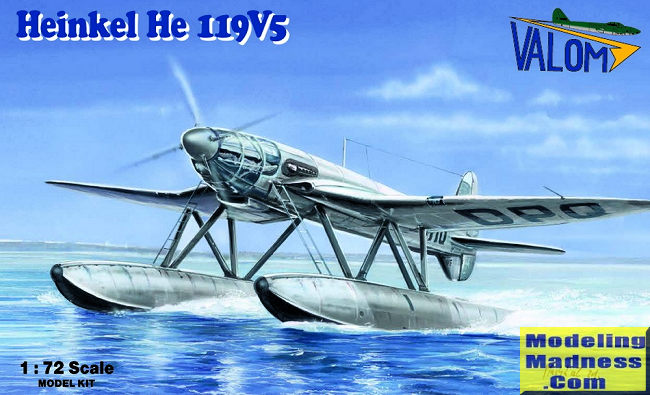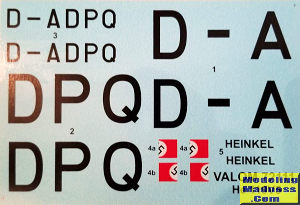
Valom 1/72 He-119v5
| KIT #: | 72111 |
| PRICE: | $26.95 |
| DECALS: | One Option |
| REVIEWER: | Mark Hiott |
| NOTES: | Kit available in several versions |

| HISTORY |
Design was begun in the late summer of 1936. The He 119's forward fuselage featured an extensively glazed cockpit forming the nose itself, heavily framed with many diagonally braced windows immediately behind the propeller spinner's rear edge.
The DB 606 was installed just behind the aft cockpit wall, near the center of gravity, with an enclosed extension shaft passing through the centerline of the extensively glazed cockpit to drive a large four-blade variable-pitch airscrew in the nose.
Two of the three-man crew sat on either side of the driveshaft, which ran aft to a "power system", a coupled pair of Daimler-Benz DB 601 engines mounted above the wing center-section within the fuselage, mounted together within a common mount (the starboard component engine having a "mirror-image" centrifugal supercharger) with a common gear reduction unit fitted to the front ends of each component engine.
An evaporative cooling system was used on the V1, with the remaining prototypes receiving a semi-retractable radiator directly below the engine to augment cooling during take-off and climb.
Only eight prototypes were completed and the aircraft did not see production, mainly because of the shortages of DB 601 "component" engines to construct the 1,500 kg (3,300 lb) "power systems" they formed. The first two prototypes were built as land planes, with retractable landing gear. The third prototype (V3) was constructed as a seaplane with twin floats. On 22 November 1937, the fourth prototype (V4) made a world class-record flight in which it recorded an airspeed of 505 km/h (314 mph), with a payload of 1,000 kg (2,205 lb), over a distance of 1,000 km (621 mi).
The four remaining aircraft were completed during the spring and early summer of 1938, the V5 and V6 being A-series production prototypes for the reconnaissance model, and the V7 and V8 being B-series production prototypes for the bomber model.
These four aircraft were three-seaters with a defensive armament of one 7.92 mm (0.312 in) MG 15 machine gun in a dorsal position, V7 and V8 having provision for a normal bombload of three 250 kg (551 lb) bombs or maximum bombload of 1,000 kg (2,205 lb). V7 and V8 were sold to Japan in May 1940, and extensively studied; the insights thus gained were used in the design of the Yokosuka R2Y.
The remaining prototypes served as engine test-beds, flying with various prototype versions of the DB 606 and DB 610 (twinned DB 605s) and the experimental DB 613 (twinned DB 603).
(Personal note: My research indicates that there is some doubt if the later aircraft: V5, V6, V7 and V8 were even built. All the aircraft were destroyed during the war, and info is a bit sketchy.)
| THE KIT |
 I
have several Valom kits and have yet to finish one, but I have a soft spot for
prototype aircraft and when I saw this kit I had to have it.
I
have several Valom kits and have yet to finish one, but I have a soft spot for
prototype aircraft and when I saw this kit I had to have it.
Molded in a light brown, the plastic shows nice detail and very little flash. The kit also includes a small PE fret, mostly for the cockpit. As with most Valom kits, there are no locating pins and the propeller has separate blades. You will also need to remove the vertical tail and replace it with the provided part. I'm not really sure you would need to do this as I doubt most people would know the difference.
The instructions are a 2 page fold out and include a separate, very nice color paint guide.
 Even though
this is the float version, the kit includes all the parts to do the land based
version, so one could, in theory, build the V1, V2 or V4 although you would need
to cobble together the decals. On that note, Valom calls this kit the V5, but
"D-ADPQ" is actually the V3. There is some doubt if the V5 was even built.
Even though
this is the float version, the kit includes all the parts to do the land based
version, so one could, in theory, build the V1, V2 or V4 although you would need
to cobble together the decals. On that note, Valom calls this kit the V5, but
"D-ADPQ" is actually the V3. There is some doubt if the V5 was even built.
On the model front, Planet models also makes resin kits of the V4 and V5 in 1/72, but they are a bit pricey. Airmodel also made a vac kit in 1/72.
| CONCLUSIONS |
A nice kit of a somewhat unusual aircraft. Typical of "short run" kits. I wouldn't recommend it for a beginner due to the build requirements, but someone with a experience should have no trouble.
June 2019
Copyright ModelingMadness.com
If you would like your product reviewed fairly and fairly quickly, please contact the editor or see other details in the Note to Contributors.
Back to the Main Page Back to the Review Index Page Back to the Previews Index Page